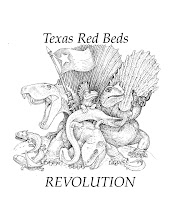(c) Dr. Robert Bakker
That's right - Dracorex hogwartsia joins the cover-model ranks of Giselle, Naomi and Kate in the December issue of National Geographic.
Dr. Bakker was the lead paleontologist on the paper that described this new species, and gave it that fabulously evocative name: Dracorex hogwartsia, literally “The Hogwartsian Dragon King.”
(Dracorex comes from the Latin word draco, for dragon, and rex, for king. Hogwarts is the name of the fictional school of magic that Harry Potter attends in the ubiquitous series of books and movies.)
It's part of a fascinating National Geographic cover story about "Extreme Dinosaurs" - represented by fossils of several new species flaunting huge spikes all over their bodies, bizarre double rows of fins along their backs or strangely elongated hands that recall the fingernail people always popping up in the Guinness Book of World Records. And the same question applies - why? How do they possibly function like that? Check out this link for photos, illustrated reconstructions and fascinating theories.
The nearly complete pachycephalosaur skull was discovered in 2003 and excavated by amateur paleontologists Steve Saulsbury, Patrick Saulsbury and Brian Buckmeier in the Late Cretaceous Hell Creek Formation of South Dakota. It was later donated to The Children’s Museum of Indianapolis.
So, does the name fit? What do you think these dinosaurs used all their funky features for?
And for all you Harry Potter fans, here's what J.K. Rowling had to say back in 2006, when the name was announced:
“The naming of Dracorex hogwartsia is easily the most unexpected honor to have come my way since the publication of the Harry Potter books! I am absolutely thrilled to think that Hogwarts has made a small (claw?) mark upon the fascinating world of dinosaurs. I happen to know more on the subject of paleontology than many might credit, because my eldest daughter was Utahraptor-obsessed and I am now living with a passionate Tyrannosaurus rex-lover, aged three. My credibility has soared within my science-loving family, and I am very much looking forward to reading Dr. Bakker’s paper describing ‘my’ dinosaur, which I can’t help visualizing as a slightly less pyromaniac Hungarian Horntail.”
Dr. Bakker was the lead paleontologist on the paper that described this new species, and gave it that fabulously evocative name: Dracorex hogwartsia, literally “The Hogwartsian Dragon King.”
(Dracorex comes from the Latin word draco, for dragon, and rex, for king. Hogwarts is the name of the fictional school of magic that Harry Potter attends in the ubiquitous series of books and movies.)
It's part of a fascinating National Geographic cover story about "Extreme Dinosaurs" - represented by fossils of several new species flaunting huge spikes all over their bodies, bizarre double rows of fins along their backs or strangely elongated hands that recall the fingernail people always popping up in the Guinness Book of World Records. And the same question applies - why? How do they possibly function like that? Check out this link for photos, illustrated reconstructions and fascinating theories.
The nearly complete pachycephalosaur skull was discovered in 2003 and excavated by amateur paleontologists Steve Saulsbury, Patrick Saulsbury and Brian Buckmeier in the Late Cretaceous Hell Creek Formation of South Dakota. It was later donated to The Children’s Museum of Indianapolis.
So, does the name fit? What do you think these dinosaurs used all their funky features for?
And for all you Harry Potter fans, here's what J.K. Rowling had to say back in 2006, when the name was announced:
“The naming of Dracorex hogwartsia is easily the most unexpected honor to have come my way since the publication of the Harry Potter books! I am absolutely thrilled to think that Hogwarts has made a small (claw?) mark upon the fascinating world of dinosaurs. I happen to know more on the subject of paleontology than many might credit, because my eldest daughter was Utahraptor-obsessed and I am now living with a passionate Tyrannosaurus rex-lover, aged three. My credibility has soared within my science-loving family, and I am very much looking forward to reading Dr. Bakker’s paper describing ‘my’ dinosaur, which I can’t help visualizing as a slightly less pyromaniac Hungarian Horntail.”

